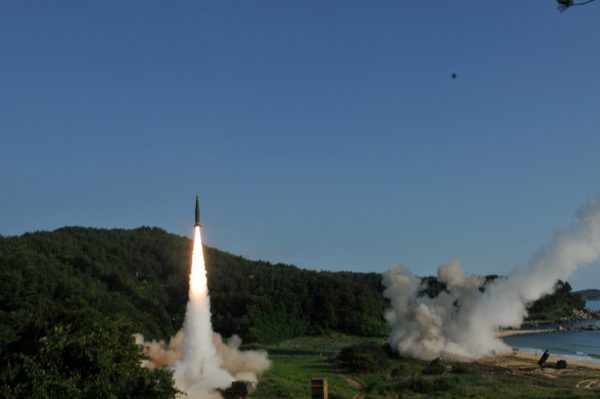Central to the current nuclear dynamics of Asia are the modernisation projects underway in every nuclear-armed state. This is not just about replacing ageing weapons systems. These nuclear modernisation projects are set to provide states with greater missile ranges, more sophisticated warhead technology, more nuclear-armed submarines patrolling Asia’s waterways, and in some cases, larger stockpiles of weapons. These improvements to the arsenals of key states such as the United States, Russia, China, India and Pakistan — alongside North Korea’s sprint towards a credible deterrent — all point to a very different nuclear future for the region.
Stability in nuclear relationships is also challenged by the increasing prominence of advanced conventional weapons. The United States once had a monopoly on advanced weapons technologies such as ballistic missile defence, conventional prompt strike missiles, and anti-satellite and cyber capabilities — all of which individually, or more importantly, in combination can upset the nuclear balance. But the race is on in China, Russia and even India to reduce Washington’s lead.
Despite the crucial role that arms control agreements have played in reducing global nuclear threats in the past, many have noted the lack of formal agreements between the nuclear-armed states in Asia. The time has come for serious attention to be given to a new era of arms control. Before specific initiatives are launched, a degree of consensus will be necessary on what a stable nuclear order in Asia should look like. Three issues stand out.
First, which actors will need to be the first movers? Despite significant reductions since the Cold War, the United States and Russia still stand head and shoulders above all others in terms of their nuclear stockpiles. Progress on arms control in Asia still seems to hinge on the US–Russia relationship. Without further progress on US–Russia nuclear reductions, China is unlikely to join the party. Until China does, India too will drag its feet with an obvious effect on Pakistan’s involvement.
Early proposals to encourage China to join the relative ‘low hanging fruit’ of the Intermediate-Range Nuclear Force Treaty between the United States and Russia have so far failed to outline any compelling incentive for it to do so. When Washington and Moscow negotiated the treaty, each side gave up something but each side gained something too — the other side foreswore the possession of an entire missile class. So China has something to give up but little to gain. By joining the treaty, Beijing would effectively be acting as if the United States, Russia and China were all nuclear equals, which is far from accurate.
Second, can the principle of mutual vulnerability still underpin nuclear relationships at all stages of arms control negotiations? This question sits at the heart of both the Sino–US strategic nuclear relationship as well as responses to North Korea’s nuclear weapons program.
In relation to the former, the growing chorus of analysts warning that China’s twin policies of ‘no first use’ and a posture of ‘minimum deterrence’ may be about to change is worth noting. This derives from Washington’s unwillingness to accept a relationship of mutual vulnerability with Beijing. Ever since the United States unilaterally withdrew from the Anti-Ballistic Missile Treaty with Russia in 2002, defence planners in Washington have been enamoured with ‘nuanced deterrence’ thinking, rejecting mutual vulnerability as the cornerstone of stability in major power relations.
The separate ballistic missile defence policy and nuclear posture reviews currently underway in the United States provide an opportunity to think carefully about this issue. The Trump administration’s dismissal of China’s concerns over the deployment of the Terminal High Altitude Area Defence (THAAD) system in South Korea is an early sign that this opportunity may well be missed. Beijing’s concerns, echoed by Moscow, has as much to do with what THAAD symbolises in terms of Washington’s reluctance to accept mutual vulnerability as it does with the specific threat this ballistic missile defence system poses vis-à-vis China’s nuclear arsenal.
Vulnerability is also central to the debate over whether it is time to reluctantly accept North Korea as a nuclear-armed state. In the absence of direct negotiations, establishing a deterrence relationship between Washington and Pyongyang is the only way to place upper limits on the size of North Korea’s arsenal. This relationship will only work if Washington accepts some degree of vulnerability. Otherwise, there is no reason for Pyongyang to believe that Washington does not harbour plans of attack.
Third is the extent to which the link between nuclear and conventional weapons can be recognised formally in arms control initiatives. If an adversary’s advanced conventional weapons threaten the reliability of a state’s second-strike capability, the temptation to improve that nuclear capability increases in exactly the kind of spiral model international relations scholars have identified for decades.
The question then is whether and how new initiatives aimed at moving Asia’s nuclear powers towards an arms control regime can address this issue. The Anti-Ballistic Missile Treaty demonstrates that addressing the nuclear-conventional link through arms control is possible in theory. Asia may well provide the ultimate test as to whether this will be possible once more.
Finding consensus on nuclear arms control in Asia will not be easy, especially as further North Korean nuclear and missile tests are likely to continue to absorb time and attention. But the immensity of the task does not diminish its importance and the promise of the ‘Asian century’ depends on establishing a stable security order. Nuclear-armed states in Asia have managed to avoid formal arms control negotiations for a remarkably long time. That time has now come to an end.
Benjamin Zala is a Research Fellow in the Department of International Relations at the Coral Bell School of Asia Pacific Affairs, The Australian National University.
This article is part of the ‘Australia, Japan, and regional security’ project organised by the Coral Bell School of Asia Pacific Affairs at ANU and the Policy Alternatives Research Institute at the University of Tokyo.

